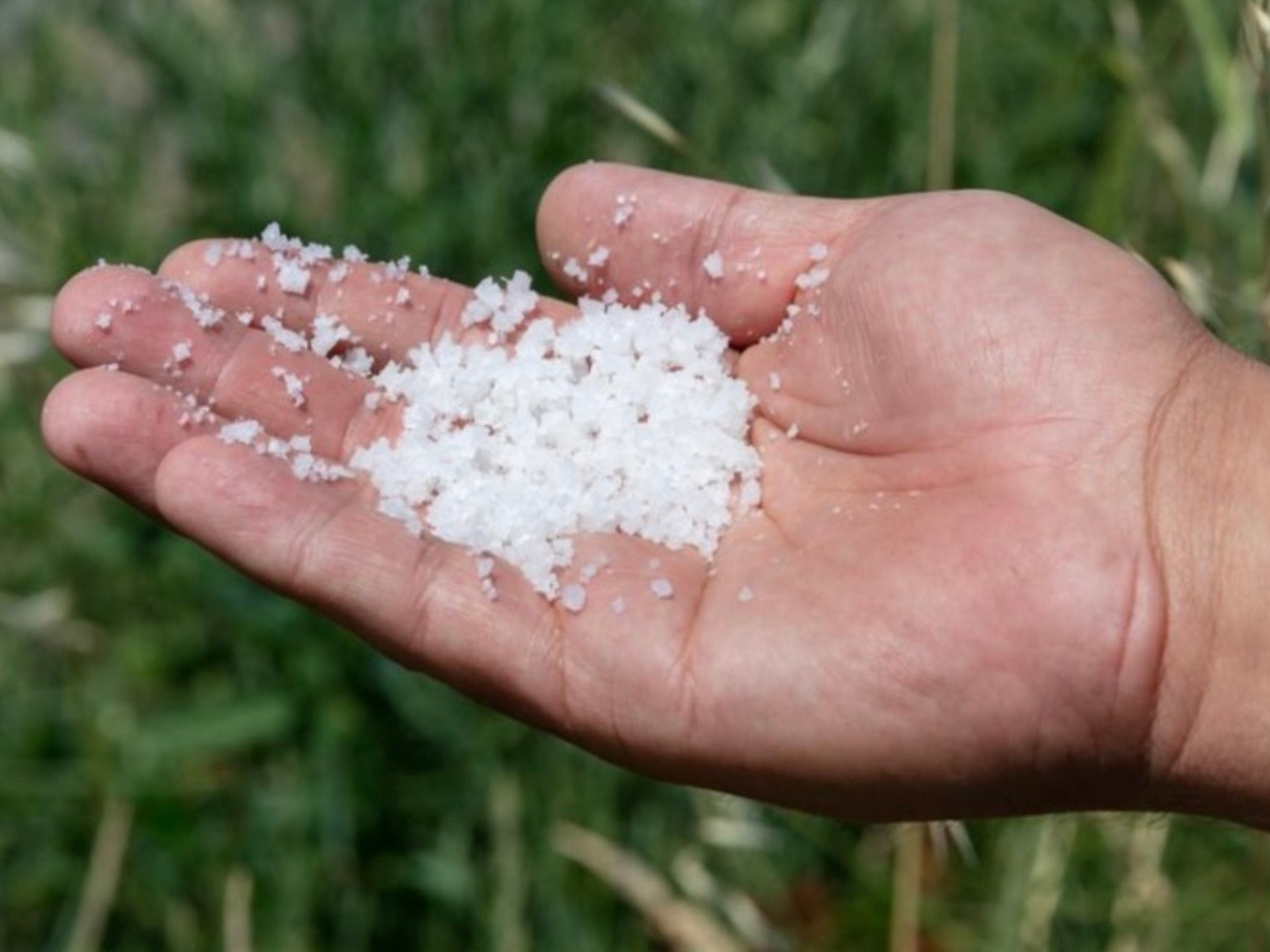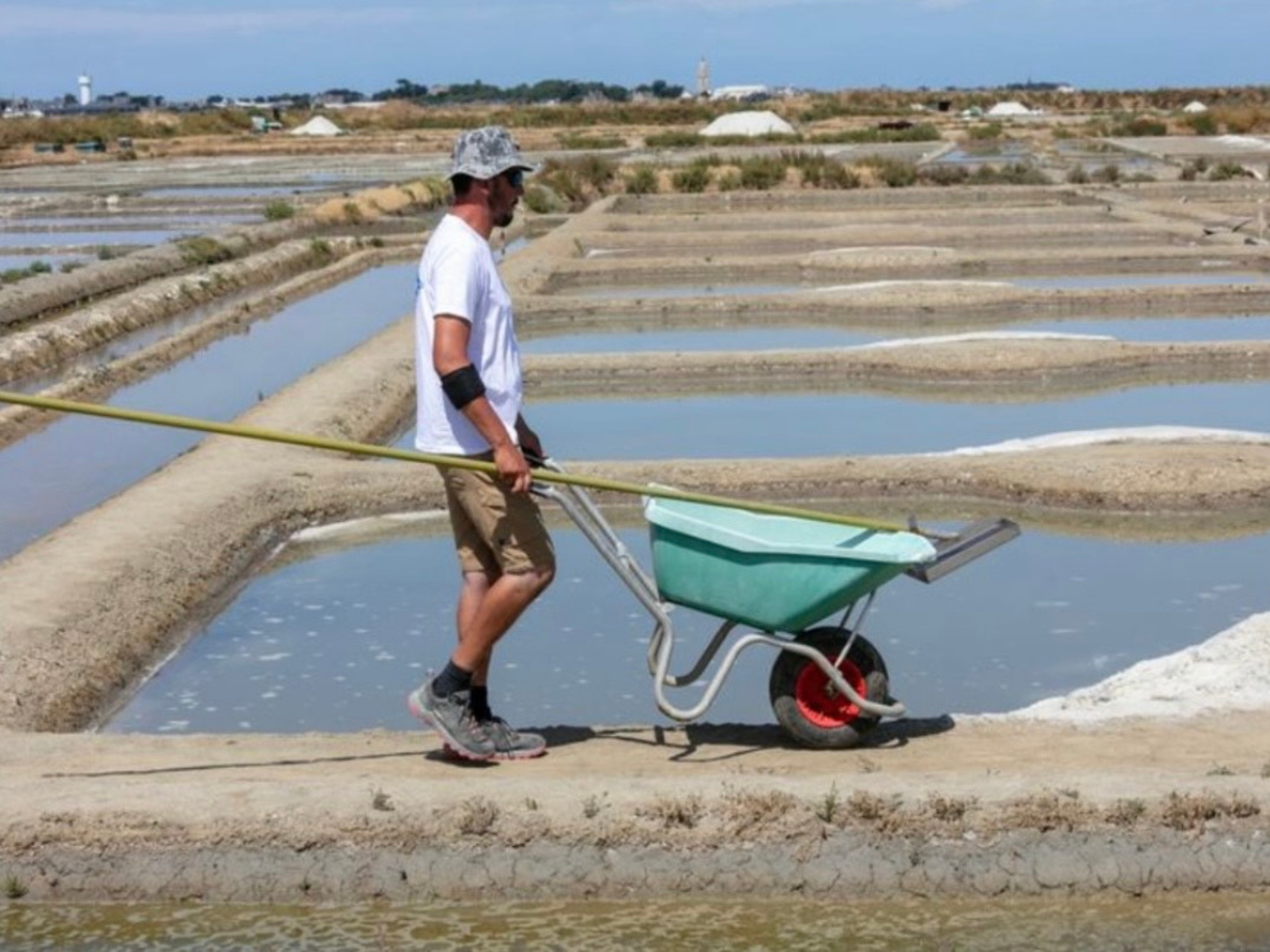Picture this: a flat, sandy-hued landscape, a clear cobalt sky, a salty breeze off the Atlantic and a patchwork of shimmering salt marshes stretching out like a natural mosaic. It’s hot – maybe 25 degrees – it’s late June and, apart from the gentle occasional chirrup of birdsong, it’s silent. This is the Guérande Peninsula in Brittany, France, where tradition and nature unite to create what locals call “white gold” – Celtic sea salt or Sel de Guérande.
Unlike ordinary table salt, this mineral-rich treasure is harvested by hand in a centuries-old craft, offering a host of health benefits and a briny burst of flavour that’s winning over chefs and wellness enthusiasts alike.
I am visiting the Guérande salt marshes to meet Xavier Delamare, the UK’s sole importer of Sel de Guérande. He’s not just a man worth his salt, he’s a man on a mission. His aim is to educate people on how Celtic sea salt is a game-changer for your health.
Here, at the marais, there are no factories or chemicals – just the weathered hands of paludiers (salt workers, from the Latin ‘palus’, meaning marsh), wielding wooden rakes in a practice dating back to the Iron Age. At the Maison des Paludiers museum in nearby Saillé, I learn how this ancient craft nearly vanished in the 1980s, only to be revived by a dedicated few who believed in its value. When the museum guide recounts this story of triumph over near-tragedy, it brings tears to my eyes.
The Guérande marshes are a sight to behold. It’s midday, getting warmer by the minute. The clay-lined ponds glisten in the heat, mirroring the cloudless sky in their glassy surface and I’m privileged to see this natural masterpiece from a breathtaking new perspective. Xavier, a licensed pilot as well as a sea salt enthusiast, takes me up in his French-made TB20, a sleek four-seater single-engine aircraft. Cruising at 150 knots (about 172 mph) and 2,000 feet above the marshes, the view is magical. From above, the intricate grid of ponds looked like an abstract painting, with shimmering threads of water weaving through the landscape catching the early morning sunlight.
“That is the best way to view the salt marshes,” Xavier says proudly after we land. The 20-minute flight is most definitely a highlight of the trip, offering a rare glimpse of the marshes’ scale and beauty.
Feet firmly back on the ground, after a bumpy bicycle ride from the village of Saillé, we meet a paludier named Fabian. He shows us around the ancient grid of ponds where seawater is naturally filtered through clay up to 17 times before being left to evaporate under the sun and wind. The result? Two types of salt: coarse ‘gros sel’, which forms at the pond’s base and the delicate ‘fleur de sel’, snow-white crystals that bloom on the surface under perfect conditions – abundant sun, low humidity and a gentle breeze.
Watching the paludiers work their long-handled rakes – a ‘las’ for coarse salt and a ‘lousse’ for the fine stuff – feels like witnessing a meditative dance with the tides. It’s labour-intensive, but the pride in their craft is clear. This isn’t just salt harvesting; it’s a way of life, unchanged for centuries.
Read more: I’ve lived with painful periods for 20 years, could ayurveda be the answer?

Over a marsh-side picnic of galettes and local cider, Xavier’s enthusiasm is infectious. “Our salt is alive!” he declares, throwing his hands into the air. He explains that refined table salt is 98 per cent sodium chloride, but Sel de Guérande contains just 71-74 per cent sodium chloride, with the rest of its composition a treasure trove of bioavailable minerals – magnesium, potassium, calcium, iron, zinc and more. “These are essential for hydration, nerve function, muscle recovery and digestion,” Xavier says.
Many experts agree. According to Jessica Shand, a nutritionist and author of The Hormone Balance Handbook, “Celtic sea salt is an unrefined, mineral-rich salt. Its natural light-grey hue comes from the clay lining of the salt ponds, which infuses the crystals with trace minerals that are largely stripped from standard table salt, making it, in my eyes, a super salt!”
Anyone who’s studied unrefined sea salts like Sel de Guérande agrees they support electrolyte balance, making them a favourite among fitness enthusiasts for post-workout hydration. “The key minerals such as magnesium, potassium, calcium, iron, manganese, zinc and iodine help with hydration and electrolyte balance,” says Shand. Magnesium aids muscle recovery, while potassium helps regulate blood pressure. The salt’s naturally moist texture and grey hue – from clay and nutrient-rich microalgae like Dunaliella Salina – signal its unprocessed purity. The clay-lined ponds also naturally filter out contaminants like microplastics, which Xavier proudly notes have never been detected.
“Our salt has never shown traces of microplastics in any analysis,” he declares. “The active filtration system, designed to remove foreign particles and contaminants, transfers seawater between ponds with precision. For example, one filter allows only bottom-layer seawater to pass to the next pond, while another permits only mid-layer seawater to move forward, using materials like sand for filtration. While absolute purity is challenging to guarantee, we confidently state that our salt is free from microplastics.”
Read more: The best infrared sauna blankets for at-home self-care, chosen by our wellbeing editor
.png)
With a lower sodium content than table salt, Celtic sea salt is a wise choice for those watching their blood pressure. Its 82 trace elements make it a “multivitamin from the sea,” as Xavier puts it, though he advises ensuring iodine intake from other sources like seaweed as Celtic sea salt isn’t fortified.
Moderation is key of course – French health authorities recommend limiting salt intake, and most of us know that too much of any kind of salt is never a good thing, so consult a doctor about your diet if you have any health conditions and especially if you suffer from hypertension (high blood pressure).
Elaborating on the benefits, Shand continues explains that, “the full spectrum of electrolytes in Celtic sea salt supports proper nerve signalling and can actually improve cellular water absorption, countering the dehydration concerns linked to refined salt. It also supports hormone and adrenal function – adequate sodium and trace minerals are essential for a healthy adrenal stress response. And it’s good for thyroid and metabolic function.”
It’s clear that Celtic sea salt is beneficial to health. In fact, in the late 19th and early 20th centuries, French biologist René Quinton conducted groundbreaking experiments demonstrating that seawater, with its mineral composition strikingly similar to human blood plasma, could support health and healing. His work, detailed in his 1904 book L’Eau de Mer, Milieu Organique (‘Seawater, Organic Medium’), showed that diluted seawater and the salt it contained could restore balance in the body, particularly in cases of malnutrition, dehydration and chronic illness.
Quinton’s most famous experiments involved injecting diluted, sterile seawater (known as Quinton Plasma) into dogs that had been – quite horribly, but such was the nature of 19th century medical experiments – bled to near death and then revived. Quinton later applied these findings to humans, using ‘Quinton Plasma’ to successfully treat conditions like cholera, tuberculosis and infant malnutrition in clinics across France. His work suggested that the trace minerals in seawater – the same ones found in Celtic sea salt – are essential for cellular function and overall vitality. Celtic sea salt’s mineral profile aligns closely with Quinton’s findings, offering a natural way to tap into the ocean’s therapeutic potential.
Dr James DiNicolantonio, a cardiovascular research scientist and author of The Salt Fix, notes that Celtic sea salt is a natural, unrefined source of essential minerals that can help replenish electrolytes and support optimal hydration. He explains that unlike processed table salt, which is stripped of its mineral content, this salt provides a balanced spectrum of trace elements that align with the body’s needs, making it a valuable addition to a health-conscious diet.
Read more: How to spot the symptoms of burnout and treat them, according to wellbeing experts

When it comes to cooking, chefs love Sel de Guérande for its complex, briny taste and Xavier, a former chef, suggests using ‘gros sel’ for cooking (perfect for salt-crusted fish or pasta water) and baking. He recommends saving fleur de sel as a finishing touch for steaks and desserts. A pinch on chocolate or caramel desserts oddly elevates sweetness, while a few grains in sugary coffee cuts bitterness.
Registered dietitian and nutritionist Elizabeth Huggins stresses that, “while Celtic sea salt is harvested from the sea or saltwater lakes through the process of evaporation, which allows it to retain trace minerals like magnesium, calcium, and potassium, these minerals are only present in trace amounts.” In her view this limits their practical impact on health. She recommends a diet of whole foods like vegetables, fruits, beans, nuts and seeds as a more effective source of these nutrients.
However, this salt does have surprising uses that seem to benefit health. Feeling queasy? A pinch in warm water can settle a dodgy stomach. Salt is crucial for digestion, aiding nutrient absorption and transporting glucose and amino acids in the intestines. It supports hydrochloric acid production, essential for breaking down food and killing bacteria. “My mother and my grandmother used it whenever we were feeling unwell,” claimed Xavier. “It’s an old remedy, used for generations in France.”
Sea salt effectively relieves acid reflux by supplying trace minerals and balancing stomach acid. When it comes to evacuating toxins, drinking a larger amount of salt causes the body’s defence mechanisms to react and attempt to maintain homeostasis by rejecting the excess amount and thus saving the body from the harm any excess would cause – in layman’s terms, it makes you vomit.
As the sun sets, casting a golden glow over the marshes, I say “au revoir” and reflect on what I’ve learned about “white gold.” I’ve long used Celtic sea salt at home but visiting Guérande has revealed not only its true origin but its magic too. This salt is a product of nature, tradition and, dare I say it, love.
Back home in England, I check my kitchen cupboard and smile. Yes, the tub of Sel de Guérande, bought in my local health food shop about a year ago was indeed, as I’d started to suspect, imported by Xavier. I wondered if it had been harvested from the same marshes I’d just visited, perhaps by paludier Fabian himself. The world suddenly feels pleasantly small.
Fabian and his fellow paludiers – with only 15 new ones trained each year – are keeping an ancient craft alive, delivering a salt that’s as good for your body as it is for your palate. So if you’re still using processed table salt, perhaps it’s time to bin it and invest in Sel de Guérande instead. Your health and your tastebuds will thank you.
Read more: Is drinking tap water bad for you? Wellness influencers say yes, but here’s what the experts think
